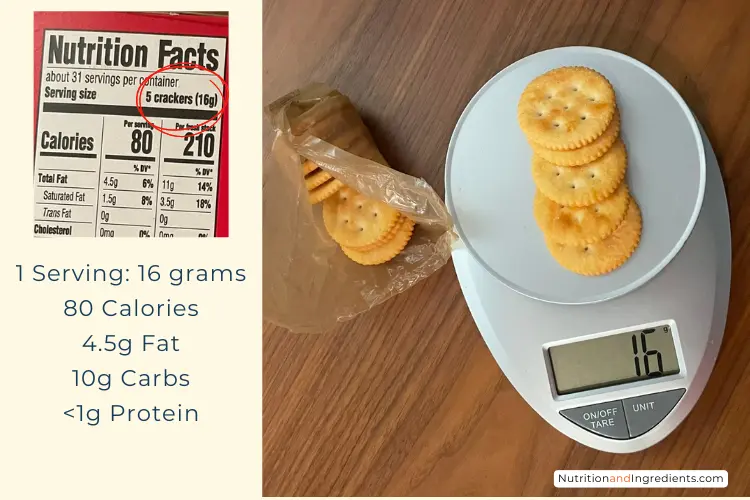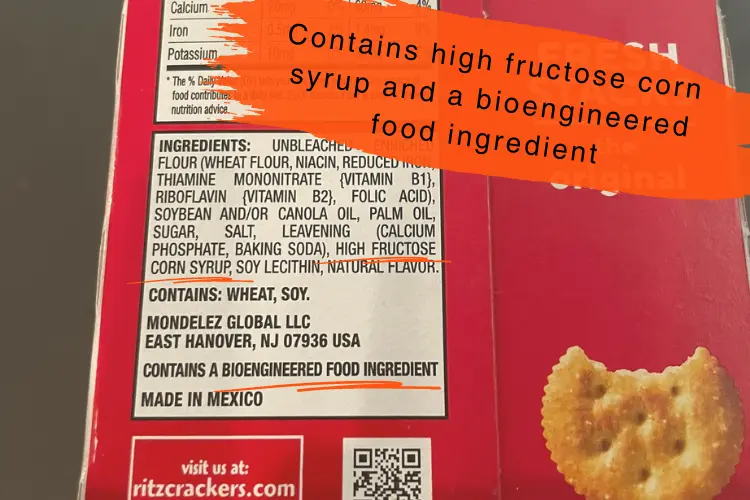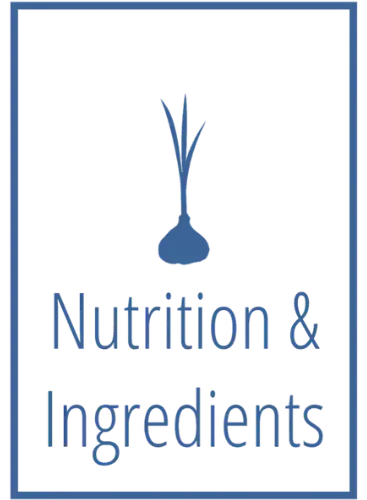Classic Ritz Crackers

Each serving of plain classic Ritz crackers has 80 calories, 4.5 grams fat, 10 grams carbohydrates, and less than one gram of protein.
This is your complete guide to the nutrition facts, calories, and ingredients in traditional Ritz crackers.
Ritz Crackers Nutritional Information
Nutrition facts are presented based on a single serving measured as five crackers with a net serving weight of 16 grams.
Daily Value
Daily value (%DV) illustrates how much a nutrient in each serving of the crackers contributes to a diet of 2,000 calories. Use %DV to compare foods and balance your choices for a healthy diet.
Review the chart below, which shows that classic Ritz are low in added sugars and have a medium level of saturated fat and sodium. However, keep in mind, the daily value is based on a serving of only 5 crackers.
Serving size: 5 Crackers
% DAILY VALUE
Use %DV to determine if the level of nutrients in a food is low (5% or less) or high (20% or more).
|
%DV |
Level | |
|---|---|---|
|
Saturated Fat |
8% |
MED |
|
Sodium |
6% |
MED |
|
Added Sugars |
2% |
LOW |
%DV based on 2,000 calories

Calories
There are 80 total calories in one serving of five Ritz crackers.
Here is a summary of calories by macronutrient, per serving:
Approximately half of the total calories are derived from fat and half from carbohydrates.
There is a nominal amount of protein in Ritz crackers. The nutrition facts label printed on the packaging indicates less than one gram. As such, zero calories are derived from protein (per measured serving).
Ritz Crackers
% calories from fat, carbs and proteinThe summary of calories by macronutrient is a rounded estimate based on the nutrition facts label printed on the Ritz cracker packaging.
ESTIMATED FITNESS TIME TO BURN 80 CALORIES
Nutrition Facts
Amount per 5 Ritz Crackers
Red indicates %DV is high.
|
Calories |
80 |
|
%DV | ||
|
Total Fat |
4.5g |
6% |
|
Saturated Fat |
1.5g |
8% |
|
Trans Fat |
0g | |
|
Cholesterol |
0mg |
0% |
|
Sodium |
130mg |
6% |
|
Carbohydrates |
10g |
4% |
|
Dietary Fiber |
0g |
0% |
|
Total Sugars |
1g | |
|
Added Sugars |
1g |
2% |
|
Protein |
<1g |
%DV based on a 2,000 calorie diet. Calorie needs vary and your %DV may be higher or lower. Provided for informational purposes only. Consult with your physician for dietary or healthcare advice.
Sodium
One serving of five Ritz crackers has 130 milligrams of sodium. That’s approximately 6% of the FDA-recommended daily limit.
According to the packaging labels, Ritz crackers are made in Mexico.

Ritz Crackers Ingredients and Allergens
Here is the complete list of ingredients in classic Ritz crackers.
Ingredients |
|---|
|
Unbleached Enriched Flour, Soybean and/or Canola Oil, Palm Oil, Sugar, Salt, Leavening, High Fructose Corn Syrup, Soy Lecithin, Natural Flavor |
Allergens
Ritz crackers are made with ingredients that contain soy and wheat.
Check the ingredients in Good Thins Simply Salt Rice Crackers.

Nutrition facts, prices, and ingredients are based on available information as of the date of publication. Restaurants and food manufacturers may change recipes or formulations without notice. Check package labels and ask the product manufacturer or restaurant for the most up-to-date information. Unless otherwise stated, %DV is based on a 2,000 calorie diet. All reports and reviews published on this site are for informational purposes only. NutritionandIngredients.com does not provide healthcare advice or dietary recommendations. Always consult your licensed physician for any healthcare or dietary advice.
Nutrition facts and ingredients source: Ritz. Always check the packaging labels for the most accurate information related to the purchased product.
